Did you know you can improve the function of your brain through acupuncture? The brain is referred to in Chinese medicine classical texts as “the sea of marrow”, and there are some acupressure points for brain stimulation that can tap directly into it. It’s well known among scientific researchers that acupuncture treatment stimulates the production of neurotransmitters that improve the function of the human brain.
The production of neurotransmitters like endorphins which are our natural painkillers, and serotonin which is related to well-being and relaxation, is stimulated with acupuncture in treatments that involve acupuncture points for brain stimulation. These neurochemicals are of crucial importance in a number of processes in the brain and body, such as:
- regulate anxiety
- may support memory and cognitive function
- heal wounds
- may support a healthy immune system
- boost self-esteem
- maintain bone health
- improve mood
- attenuate inflammation
- reduce pain and discomfort
- increase pleasure
- reduce stress, depression, and anxiety
- improve chronic pain
- regulate sleep and libido
The brain is a complex organ that is involved in the function of the whole body through the nervous system. A magnetic resonance imaging study has shown that manual acupuncture triggered the remapping of the primary somatosensory cortex of the brain in patients suffering from carpal tunnel syndrome, a neuropathic pain disorder that affects the wrists.
The reason why this study is so relevant in the endorsement of acupuncture needle stimulation is that it shows scientifically how manual acupuncture is not just a placebo treatment, as it is still believed in many scientific communities. Acupressure points for brain power are yet to be studied. However, they have been utilized traditionally for thousands of years in all the countries where the practice of acupuncture has reached.
Does Acupressure Increase Brain Power?

If you were to ask a traditional Chinese medicine practitioner whether you can increase your brain power with acupuncture needle stimulation in the acupressure points for brain stimulation, the answer you would get would most likely be on TCM’s own terms, which do not speak of brain power the same way as in Western physiology. A truly powerful person, from the point of view of TCM, is the result of a balance between the Brain, or “sea of marrow”, and the Spirit, or Shen, which resides in the Heart.
There are acupoints that benefit the brain, and they are used in acupuncture for brain aneurysm, strokes, brain injuries, etc. Though, in traditional language, the effects of acupressure on the brain are explained in terms of the results that can be observed. A sharp brain in TCM is considered the reflection of the good vitality the person is enjoying. The acupressure points for brain stimulation tap into the meridians that are directly or indirectly connected to the brain.
With fMRI studies, it is becoming possible to say just how the treatment with acupuncture affects the brain by activating specific brain areas and releasing neurochemicals. There is one study carried out by George Lewith from the University of Southampton that was published in the renowned Nature Journal of Science showing exactly that. However, future studies are needed in order to reveal the mechanism behind the practice of acupressure, and its effects, such as in acupressure for brain tumors.
Acupressure Points For Brain Stimulation
Most of the acupoints we’ll feature here are local acupressure points for brain stimulation that modulate certain brain functions, improving connectivity between the required areas and diminishing it where it is harmful. Others are acupoints that relax the muscles around the skull that can become stiff, becoming a mechanical hindrance to the circulation of blood and nutrients in the area.
It’s good to remember that there are many scientific studies showing how exactly acupuncture points, when stimulated, can cause the production of essential neurotransmitters, like endorphins, which are the body’s own opioids, as well as serotonin, which promote stem cell production and even improve the recovery of neuronal function in some cases of injury.
This is a simple acupressure protocol that you can do at home and which helps you to release the tensions of everyday life. Remember to stick to your acupressure practice and be consistent with it in order to get the most out of it. In addition to that, you can also recur to this acupressure protocol if you’re suffering from an occasional headache.
Acupoint: TE-5 (Other Names: Triple Energizer-5/Wai Guan/Outer Pass)
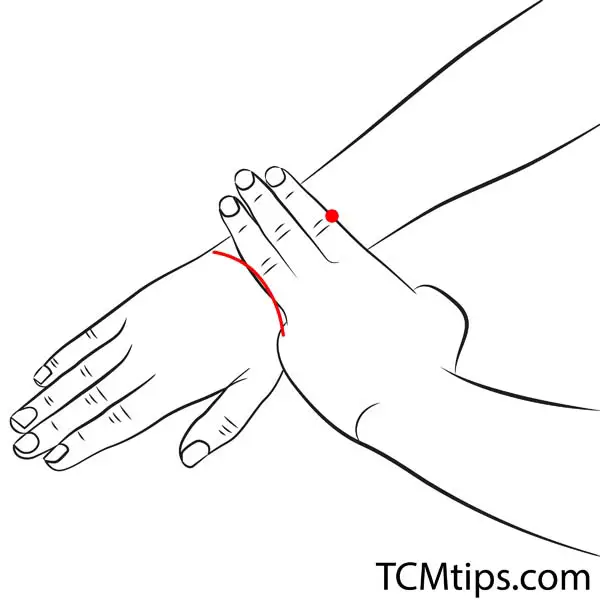

You can find this acupoint with your hand facing down, at 2 cun from the crest of your wrist on your forearm. Due to its location, this point is utilized in acupuncture for tendonitis in the hand.
Waiguan, as this acupoint is also known, is a powerful acupoint traditionally utilized to treat all lack of physical and psychological warmth. TE-5 is one of the most important acupoints in the treatment of ischemic stroke, as it was shown to improve the connections in the central nervous system as well as the autonomic nervous system. This point improves the functional state and connectivity of sensorimotor areas in the brain, which directly cause better performance in everyday tasks as well as in the work of professionals.
Repeat pressing the acupoint TE-5 for 5 seconds while taking deep breaths, about 3 times on both sides. This is also one of the acupuncture points for the brain.
Acupoint: TE-20 (Other Names: Triple Energizer-20/Jiao Sun/Minute Angle)

This acupoint is located above the tip of the ear at the natural hairline.
The temporalis muscle is easily stiffened by stress and chewing. Stimulation of acupressure points around the temples and ears can stimulate blood circulation in the temporal region, which is good for migraine headaches and tinnitus. It is included in our list of acupressure points for brain fog and acupressure points for hair growth.
Press this acupoint for 5 seconds while taking deep breaths and doing circular movements with your fingers, do this about 3 times on both sides.
Acupoint: GB-8 (Other Names: Gallbladder-8/Shuai Gu/Leading Valley)
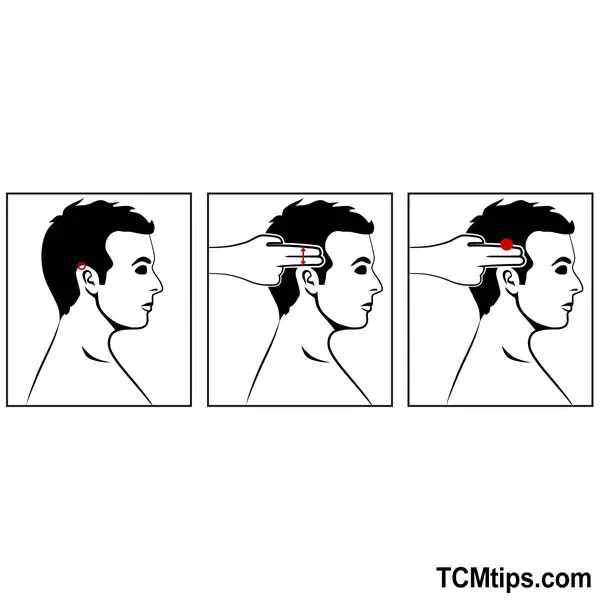
This point is located directly above the apex of the ear, 1.5 cun, or two finger widths above the natural hairline.
This is an important acupoint in the treatment of temporal or parietal headache and heaviness, especially when unilaterally stimulated. It’s among the pressure points for migraine relief. Shuaigu, as this acupoint is also known, has also been shown to treat migraine by regulating certain connections in the brain.
Massage this acupoint for 5 seconds, making circular movements with your fingers. You can repeat this about 3 times bilaterally.
Acupoint: GB-15 (Other Names: Gallbladder-15/Tou Lin Qi/Head Governor of Tears)
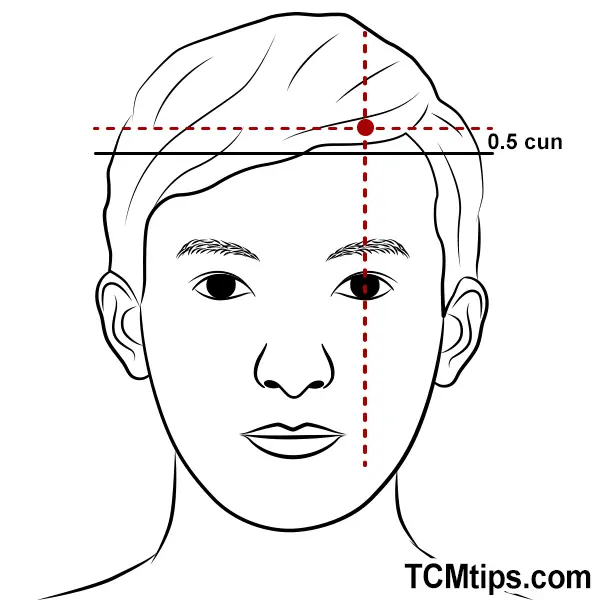
GB-15 is found 0.5 cun within the anterior hairline, aligned with the pupils.
GB-15 has strong effects on emotional state and is particularly effective in mood balancing when a person oscillates between “ups and downs”, by regulating the human brain. Other uses of this acupoint in clinical practice are headache, visual dizziness, pain in the occiput and forehead, and pain in the supraorbital ridge.
Massage this acupoint for three minutes, applying a circular motion with your fingers.
Acupoint: GB-14 (Other Names: Gallbladder-14/Yang Bai/Yang White)
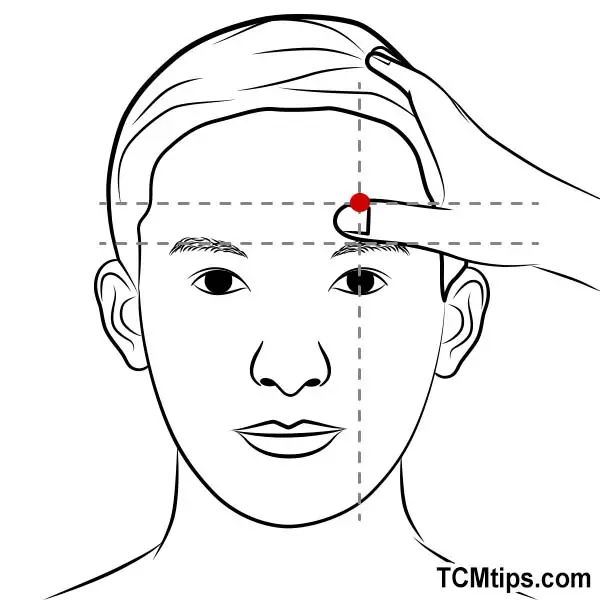
This acupoint is located directly above the pupils of both eyes, 1 cun above the midpoint of the eyebrows.
This area tends to become stiff when looking down due to long hours at the desk or frequent smartphone operation. Stimulation of acupoints in the occipital region is believed to lighten muscle tension headaches and is also effective for dizziness and tinnitus. It’s among the acupuncture points for concussion as well. This is the local command point for the treatment of pain in the forehead and is a major point for treating problems in the eyes and eyelids. For this reason, GB-14 is largely utilized in acupressure for better vision.
Firmly press this acupoint for a few seconds, releasing it intermittently. You can repeat this about 3 times on both sides.
Acupoint: Bl-10 (Other Names: Urinary Bladder-10/Tian Zhu/Celestial Pillar)
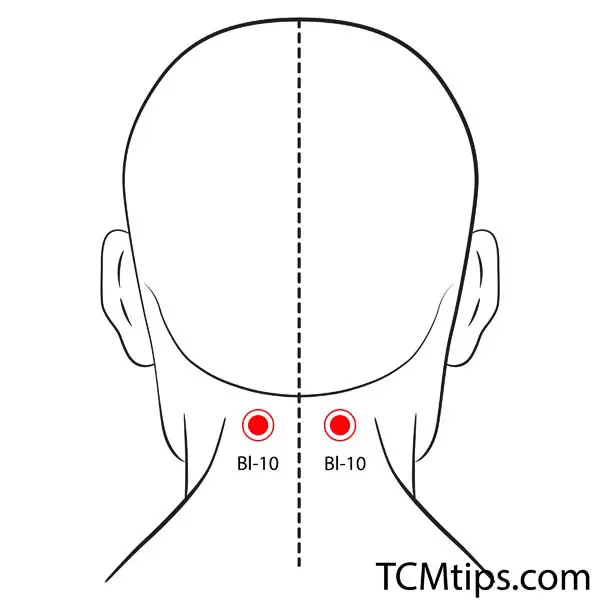
Bl-10 is found 1.3 cun lateral to the midpoint of the posterior hairline in the depression on the lateral aspect of the trapezius.
Bl-10 is a major point for occipital headache. It is connected to the Foot Taiyang Urinary Bladder channel, which leaves from the inner corner of the eye and ascends along the front to the vertex before continuing on the neck. This acupoint is traditionally indicated when chaotic and rebellious qi rises to the head. It benefits the head and sensory orifices and clears the Brain. This is one of the acupressure points for cataracts as well.
Press each acupoint for about 5 seconds with the thumbs or index fingers. Repeat this at least three times.
Acupoint: ST-36 (Other Names: Stomach-36/Zu San Li/Leg Three Miles)

Find ST-36 Zusanli below your knee, one finger breadth lateral to the anterior crest of the tibia.
Daily moxibustion in this acupoint is said to extend the lifespan and helps to maintain health, being specially indicated to people above thirty to send energy to the eyes. In scientific studies, the stimulation of Zusanli, in combination with another acupoint, was shown to effectively counteract oxidative stress. It can regulate the gut-brain balance. It is one of the best acupressure points for brain injury.
ST-36 is also utilized in acupuncture for eye bags. Discover why!
Sitting on a chair, press this acupoint for 5 seconds with your fingers, and repeat this about 3 more times on both sides.

Try our Anti-Aging Gua Sha Tool designed to bring out your skin’s natural glow.
Best Gua Sha Product- Anti-Aging: The tool is designed to target 11 specific aging signs such as wrinkles and sagging skin. By following the 7-step routine, users can improve skin firmness and reduce fine lines naturally.
- Enhances Skincare Routine: It works effectively with serums and lotions, boosting absorption and efficacy of skincare products.
- Visible Skin Improvement: Users can expect a smoother complexion, reduced puffiness, and a more youthful appearance.
 P. Sze
P. Sze 

















